Business Law Report: Analysis of UK Business Law and Practices
VerifiedAdded on 2020/01/28
|17
|5867
|123
Report
AI Summary
This report provides a comprehensive analysis of UK business law, focusing on consumer rights, credit agreements, and agency law. It examines the application of legal rules to the supply of services and sale of goods, statutory provisions on possession and property transfer, and remedies for both sellers and buyers. The report also delves into product liability, notices, rules, and termination rights. Furthermore, it explores different credit agreements, types of agents, their duties and rights, and anti-competitive practices and monopolies in the UK legislation. The role of the competition commission, definitions of dominant positions, and applications of anti-competitive practices on EU exemptions are also discussed. Finally, the report identifies different intellectual properties, compares business names and trademarks, and offers advice on protecting inventions through infringement and patent rights, as well as copyright protection.
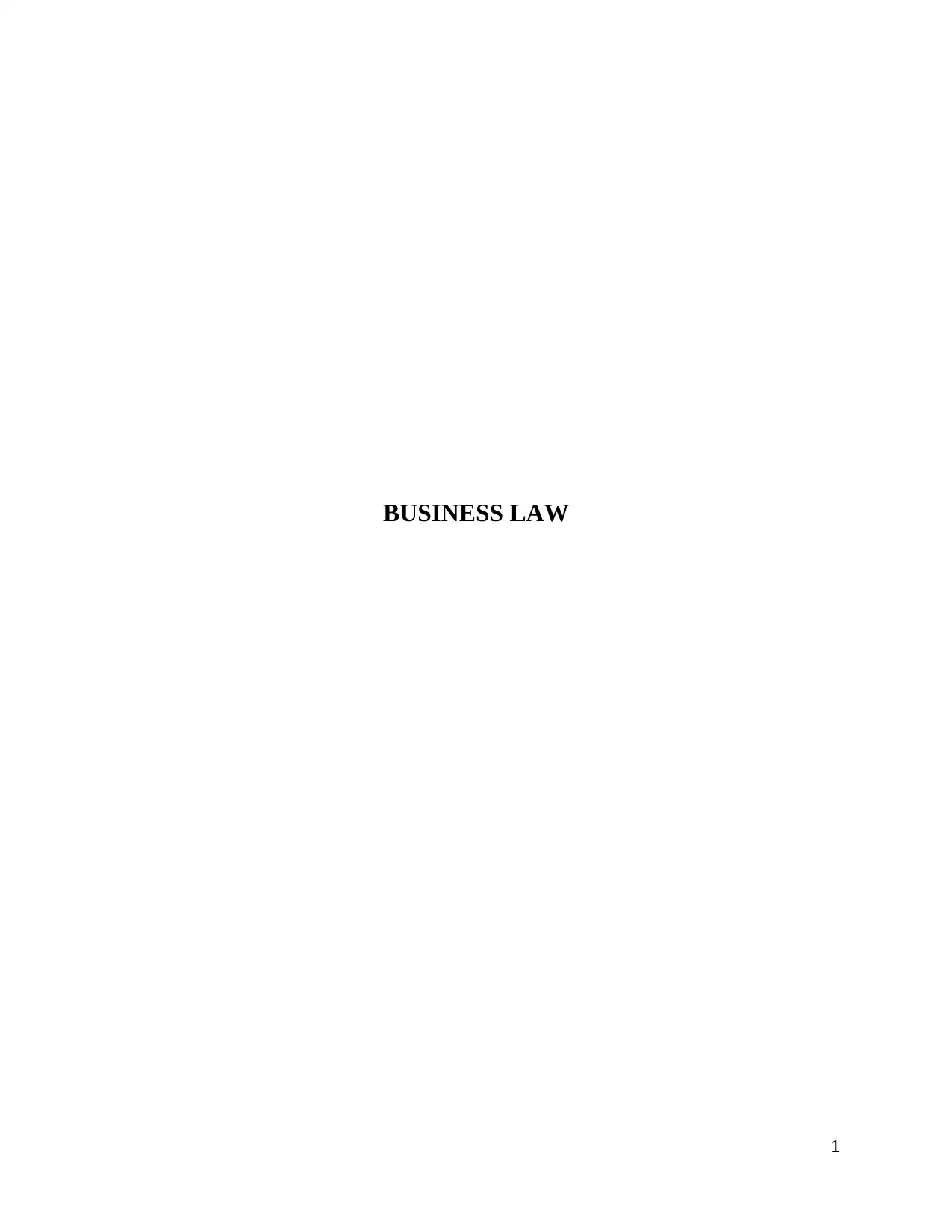
BUSINESS LAW
1
1
Paraphrase This Document
Need a fresh take? Get an instant paraphrase of this document with our AI Paraphraser
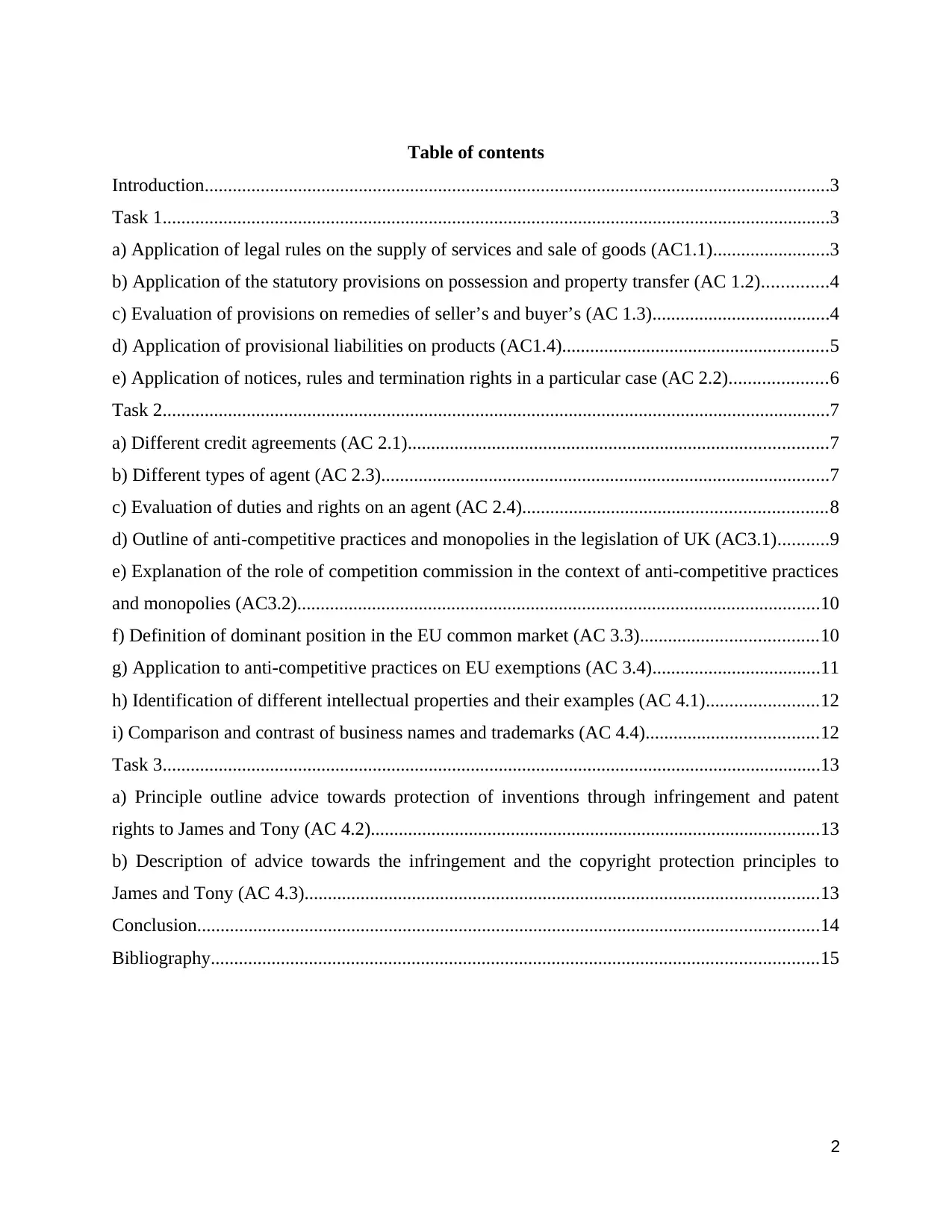
Table of contents
Introduction......................................................................................................................................3
Task 1...............................................................................................................................................3
a) Application of legal rules on the supply of services and sale of goods (AC1.1).........................3
b) Application of the statutory provisions on possession and property transfer (AC 1.2)..............4
c) Evaluation of provisions on remedies of seller’s and buyer’s (AC 1.3)......................................4
d) Application of provisional liabilities on products (AC1.4).........................................................5
e) Application of notices, rules and termination rights in a particular case (AC 2.2).....................6
Task 2...............................................................................................................................................7
a) Different credit agreements (AC 2.1)..........................................................................................7
b) Different types of agent (AC 2.3)................................................................................................7
c) Evaluation of duties and rights on an agent (AC 2.4).................................................................8
d) Outline of anti-competitive practices and monopolies in the legislation of UK (AC3.1)...........9
e) Explanation of the role of competition commission in the context of anti-competitive practices
and monopolies (AC3.2)................................................................................................................10
f) Definition of dominant position in the EU common market (AC 3.3)......................................10
g) Application to anti-competitive practices on EU exemptions (AC 3.4)....................................11
h) Identification of different intellectual properties and their examples (AC 4.1)........................12
i) Comparison and contrast of business names and trademarks (AC 4.4).....................................12
Task 3.............................................................................................................................................13
a) Principle outline advice towards protection of inventions through infringement and patent
rights to James and Tony (AC 4.2)................................................................................................13
b) Description of advice towards the infringement and the copyright protection principles to
James and Tony (AC 4.3)..............................................................................................................13
Conclusion.....................................................................................................................................14
Bibliography..................................................................................................................................15
2
Introduction......................................................................................................................................3
Task 1...............................................................................................................................................3
a) Application of legal rules on the supply of services and sale of goods (AC1.1).........................3
b) Application of the statutory provisions on possession and property transfer (AC 1.2)..............4
c) Evaluation of provisions on remedies of seller’s and buyer’s (AC 1.3)......................................4
d) Application of provisional liabilities on products (AC1.4).........................................................5
e) Application of notices, rules and termination rights in a particular case (AC 2.2).....................6
Task 2...............................................................................................................................................7
a) Different credit agreements (AC 2.1)..........................................................................................7
b) Different types of agent (AC 2.3)................................................................................................7
c) Evaluation of duties and rights on an agent (AC 2.4).................................................................8
d) Outline of anti-competitive practices and monopolies in the legislation of UK (AC3.1)...........9
e) Explanation of the role of competition commission in the context of anti-competitive practices
and monopolies (AC3.2)................................................................................................................10
f) Definition of dominant position in the EU common market (AC 3.3)......................................10
g) Application to anti-competitive practices on EU exemptions (AC 3.4)....................................11
h) Identification of different intellectual properties and their examples (AC 4.1)........................12
i) Comparison and contrast of business names and trademarks (AC 4.4).....................................12
Task 3.............................................................................................................................................13
a) Principle outline advice towards protection of inventions through infringement and patent
rights to James and Tony (AC 4.2)................................................................................................13
b) Description of advice towards the infringement and the copyright protection principles to
James and Tony (AC 4.3)..............................................................................................................13
Conclusion.....................................................................................................................................14
Bibliography..................................................................................................................................15
2
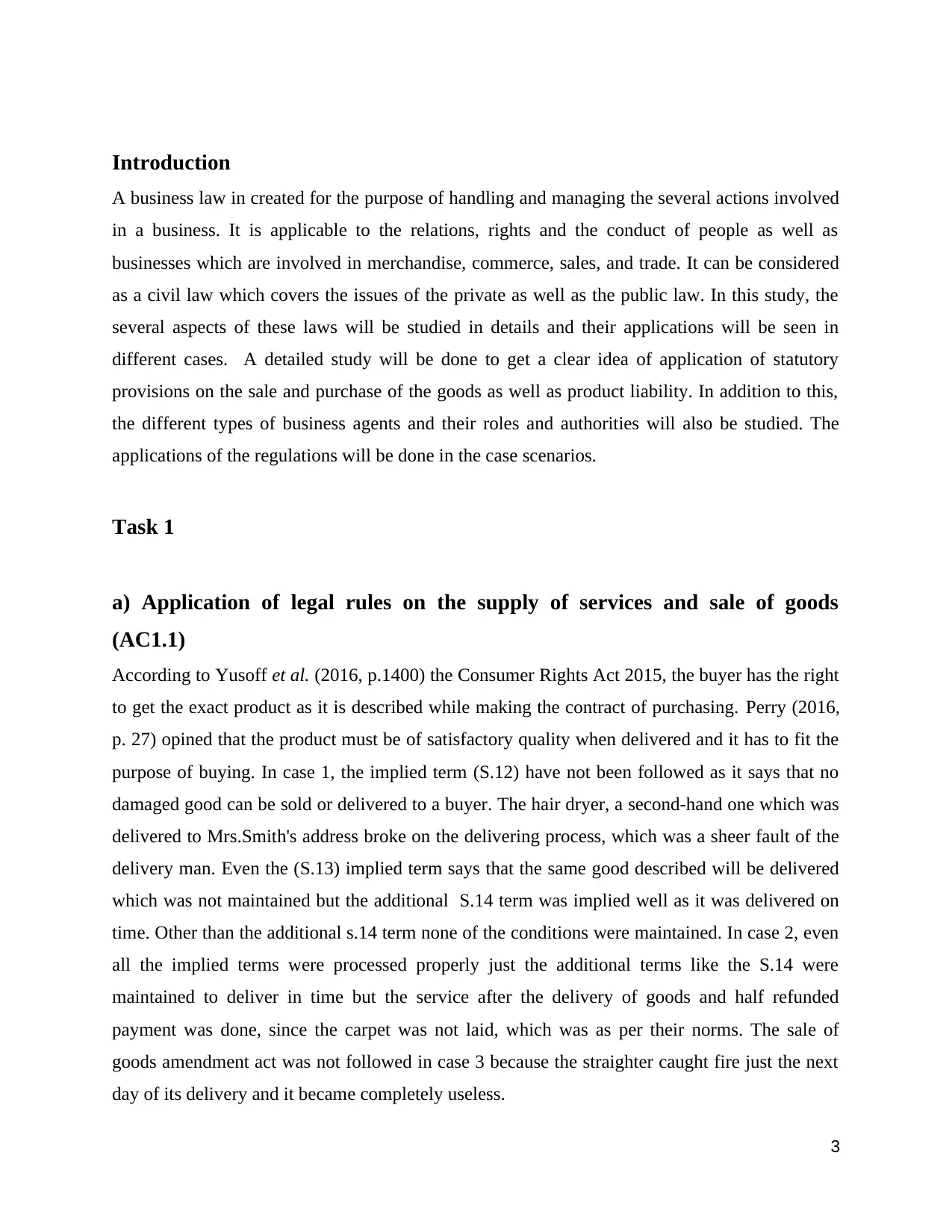
Introduction
A business law in created for the purpose of handling and managing the several actions involved
in a business. It is applicable to the relations, rights and the conduct of people as well as
businesses which are involved in merchandise, commerce, sales, and trade. It can be considered
as a civil law which covers the issues of the private as well as the public law. In this study, the
several aspects of these laws will be studied in details and their applications will be seen in
different cases. A detailed study will be done to get a clear idea of application of statutory
provisions on the sale and purchase of the goods as well as product liability. In addition to this,
the different types of business agents and their roles and authorities will also be studied. The
applications of the regulations will be done in the case scenarios.
Task 1
a) Application of legal rules on the supply of services and sale of goods
(AC1.1)
According to Yusoff et al. (2016, p.1400) the Consumer Rights Act 2015, the buyer has the right
to get the exact product as it is described while making the contract of purchasing. Perry (2016,
p. 27) opined that the product must be of satisfactory quality when delivered and it has to fit the
purpose of buying. In case 1, the implied term (S.12) have not been followed as it says that no
damaged good can be sold or delivered to a buyer. The hair dryer, a second-hand one which was
delivered to Mrs.Smith's address broke on the delivering process, which was a sheer fault of the
delivery man. Even the (S.13) implied term says that the same good described will be delivered
which was not maintained but the additional S.14 term was implied well as it was delivered on
time. Other than the additional s.14 term none of the conditions were maintained. In case 2, even
all the implied terms were processed properly just the additional terms like the S.14 were
maintained to deliver in time but the service after the delivery of goods and half refunded
payment was done, since the carpet was not laid, which was as per their norms. The sale of
goods amendment act was not followed in case 3 because the straighter caught fire just the next
day of its delivery and it became completely useless.
3
A business law in created for the purpose of handling and managing the several actions involved
in a business. It is applicable to the relations, rights and the conduct of people as well as
businesses which are involved in merchandise, commerce, sales, and trade. It can be considered
as a civil law which covers the issues of the private as well as the public law. In this study, the
several aspects of these laws will be studied in details and their applications will be seen in
different cases. A detailed study will be done to get a clear idea of application of statutory
provisions on the sale and purchase of the goods as well as product liability. In addition to this,
the different types of business agents and their roles and authorities will also be studied. The
applications of the regulations will be done in the case scenarios.
Task 1
a) Application of legal rules on the supply of services and sale of goods
(AC1.1)
According to Yusoff et al. (2016, p.1400) the Consumer Rights Act 2015, the buyer has the right
to get the exact product as it is described while making the contract of purchasing. Perry (2016,
p. 27) opined that the product must be of satisfactory quality when delivered and it has to fit the
purpose of buying. In case 1, the implied term (S.12) have not been followed as it says that no
damaged good can be sold or delivered to a buyer. The hair dryer, a second-hand one which was
delivered to Mrs.Smith's address broke on the delivering process, which was a sheer fault of the
delivery man. Even the (S.13) implied term says that the same good described will be delivered
which was not maintained but the additional S.14 term was implied well as it was delivered on
time. Other than the additional s.14 term none of the conditions were maintained. In case 2, even
all the implied terms were processed properly just the additional terms like the S.14 were
maintained to deliver in time but the service after the delivery of goods and half refunded
payment was done, since the carpet was not laid, which was as per their norms. The sale of
goods amendment act was not followed in case 3 because the straighter caught fire just the next
day of its delivery and it became completely useless.
3
⊘ This is a preview!⊘
Do you want full access?
Subscribe today to unlock all pages.

Trusted by 1+ million students worldwide
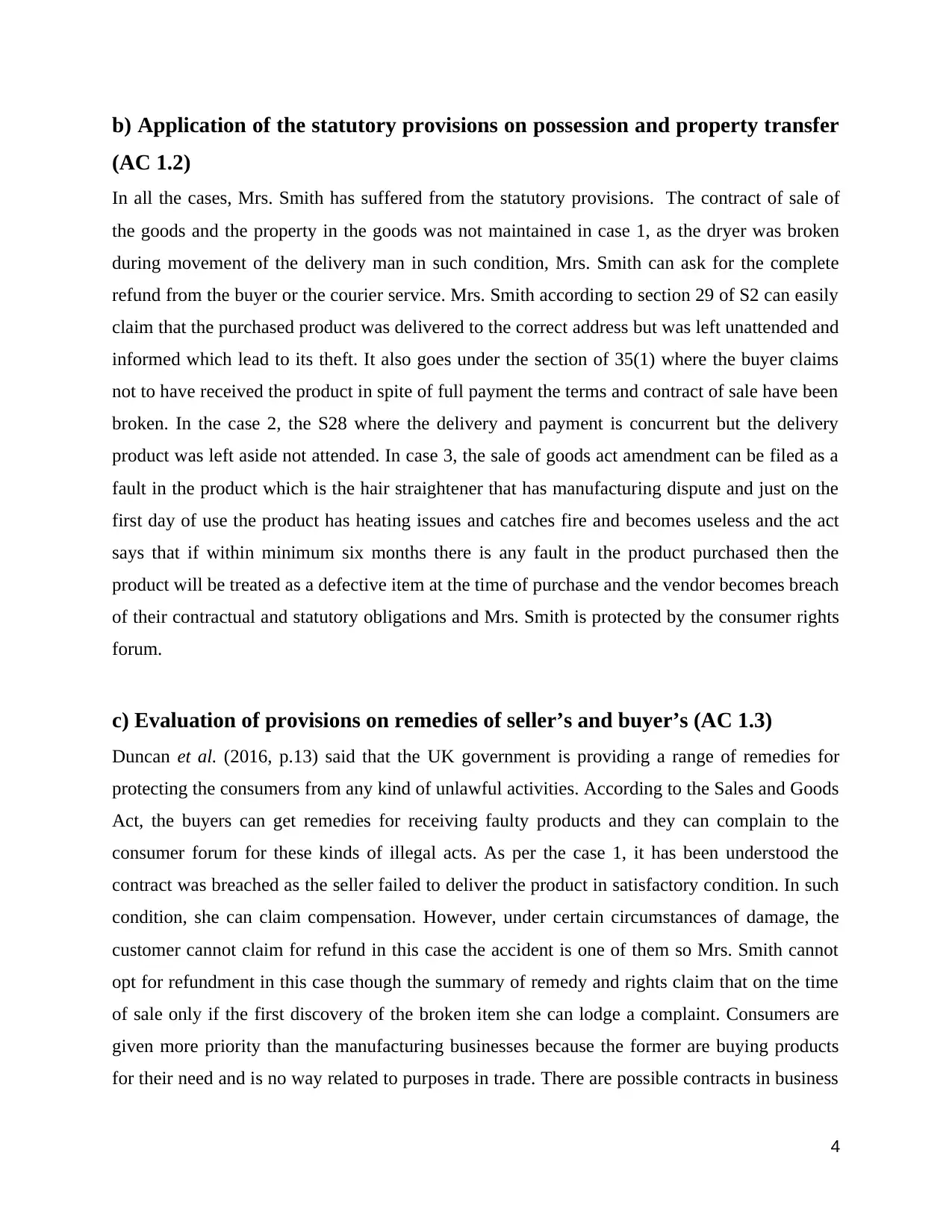
b) Application of the statutory provisions on possession and property transfer
(AC 1.2)
In all the cases, Mrs. Smith has suffered from the statutory provisions. The contract of sale of
the goods and the property in the goods was not maintained in case 1, as the dryer was broken
during movement of the delivery man in such condition, Mrs. Smith can ask for the complete
refund from the buyer or the courier service. Mrs. Smith according to section 29 of S2 can easily
claim that the purchased product was delivered to the correct address but was left unattended and
informed which lead to its theft. It also goes under the section of 35(1) where the buyer claims
not to have received the product in spite of full payment the terms and contract of sale have been
broken. In the case 2, the S28 where the delivery and payment is concurrent but the delivery
product was left aside not attended. In case 3, the sale of goods act amendment can be filed as a
fault in the product which is the hair straightener that has manufacturing dispute and just on the
first day of use the product has heating issues and catches fire and becomes useless and the act
says that if within minimum six months there is any fault in the product purchased then the
product will be treated as a defective item at the time of purchase and the vendor becomes breach
of their contractual and statutory obligations and Mrs. Smith is protected by the consumer rights
forum.
c) Evaluation of provisions on remedies of seller’s and buyer’s (AC 1.3)
Duncan et al. (2016, p.13) said that the UK government is providing a range of remedies for
protecting the consumers from any kind of unlawful activities. According to the Sales and Goods
Act, the buyers can get remedies for receiving faulty products and they can complain to the
consumer forum for these kinds of illegal acts. As per the case 1, it has been understood the
contract was breached as the seller failed to deliver the product in satisfactory condition. In such
condition, she can claim compensation. However, under certain circumstances of damage, the
customer cannot claim for refund in this case the accident is one of them so Mrs. Smith cannot
opt for refundment in this case though the summary of remedy and rights claim that on the time
of sale only if the first discovery of the broken item she can lodge a complaint. Consumers are
given more priority than the manufacturing businesses because the former are buying products
for their need and is no way related to purposes in trade. There are possible contracts in business
4
(AC 1.2)
In all the cases, Mrs. Smith has suffered from the statutory provisions. The contract of sale of
the goods and the property in the goods was not maintained in case 1, as the dryer was broken
during movement of the delivery man in such condition, Mrs. Smith can ask for the complete
refund from the buyer or the courier service. Mrs. Smith according to section 29 of S2 can easily
claim that the purchased product was delivered to the correct address but was left unattended and
informed which lead to its theft. It also goes under the section of 35(1) where the buyer claims
not to have received the product in spite of full payment the terms and contract of sale have been
broken. In the case 2, the S28 where the delivery and payment is concurrent but the delivery
product was left aside not attended. In case 3, the sale of goods act amendment can be filed as a
fault in the product which is the hair straightener that has manufacturing dispute and just on the
first day of use the product has heating issues and catches fire and becomes useless and the act
says that if within minimum six months there is any fault in the product purchased then the
product will be treated as a defective item at the time of purchase and the vendor becomes breach
of their contractual and statutory obligations and Mrs. Smith is protected by the consumer rights
forum.
c) Evaluation of provisions on remedies of seller’s and buyer’s (AC 1.3)
Duncan et al. (2016, p.13) said that the UK government is providing a range of remedies for
protecting the consumers from any kind of unlawful activities. According to the Sales and Goods
Act, the buyers can get remedies for receiving faulty products and they can complain to the
consumer forum for these kinds of illegal acts. As per the case 1, it has been understood the
contract was breached as the seller failed to deliver the product in satisfactory condition. In such
condition, she can claim compensation. However, under certain circumstances of damage, the
customer cannot claim for refund in this case the accident is one of them so Mrs. Smith cannot
opt for refundment in this case though the summary of remedy and rights claim that on the time
of sale only if the first discovery of the broken item she can lodge a complaint. Consumers are
given more priority than the manufacturing businesses because the former are buying products
for their need and is no way related to purposes in trade. There are possible contracts in business
4
Paraphrase This Document
Need a fresh take? Get an instant paraphrase of this document with our AI Paraphraser
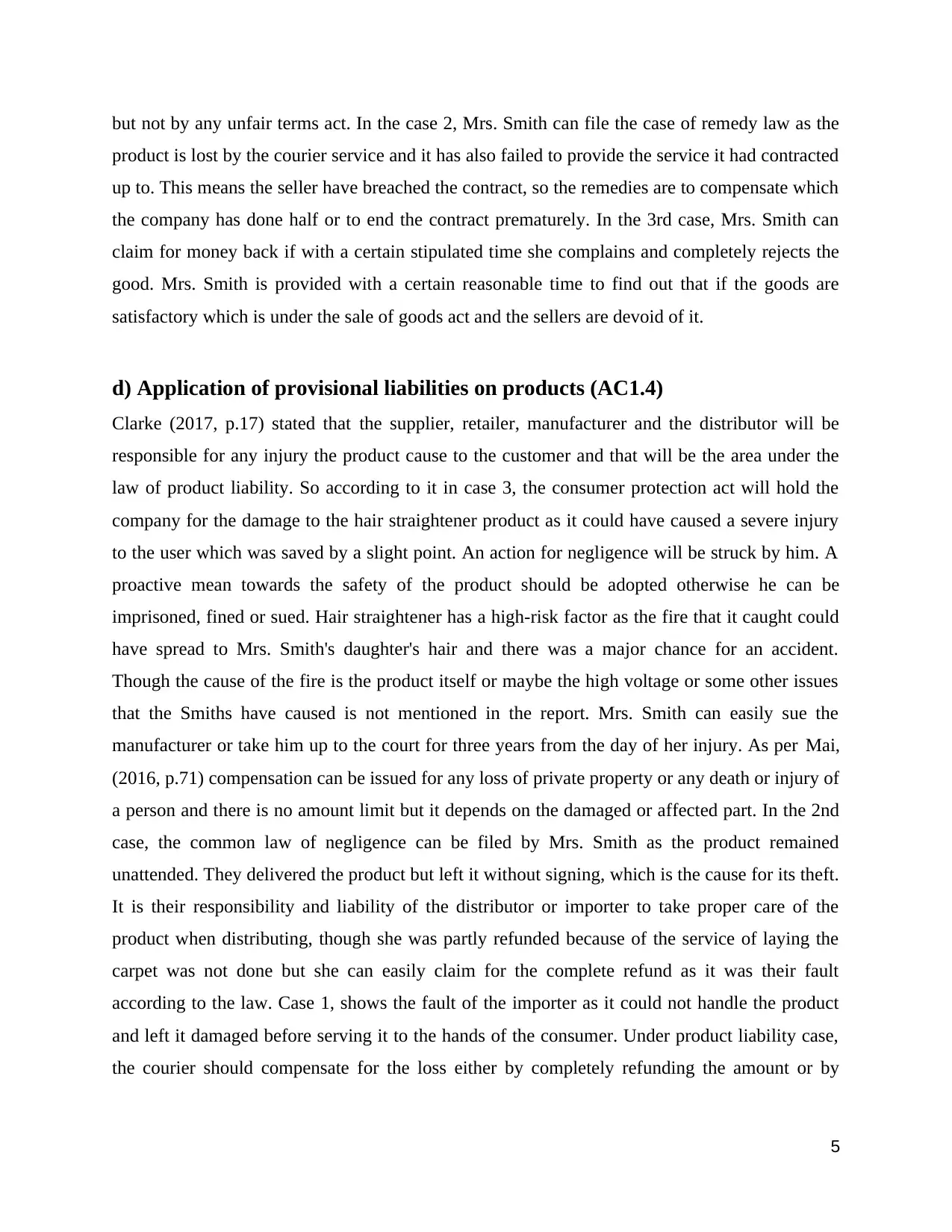
but not by any unfair terms act. In the case 2, Mrs. Smith can file the case of remedy law as the
product is lost by the courier service and it has also failed to provide the service it had contracted
up to. This means the seller have breached the contract, so the remedies are to compensate which
the company has done half or to end the contract prematurely. In the 3rd case, Mrs. Smith can
claim for money back if with a certain stipulated time she complains and completely rejects the
good. Mrs. Smith is provided with a certain reasonable time to find out that if the goods are
satisfactory which is under the sale of goods act and the sellers are devoid of it.
d) Application of provisional liabilities on products (AC1.4)
Clarke (2017, p.17) stated that the supplier, retailer, manufacturer and the distributor will be
responsible for any injury the product cause to the customer and that will be the area under the
law of product liability. So according to it in case 3, the consumer protection act will hold the
company for the damage to the hair straightener product as it could have caused a severe injury
to the user which was saved by a slight point. An action for negligence will be struck by him. A
proactive mean towards the safety of the product should be adopted otherwise he can be
imprisoned, fined or sued. Hair straightener has a high-risk factor as the fire that it caught could
have spread to Mrs. Smith's daughter's hair and there was a major chance for an accident.
Though the cause of the fire is the product itself or maybe the high voltage or some other issues
that the Smiths have caused is not mentioned in the report. Mrs. Smith can easily sue the
manufacturer or take him up to the court for three years from the day of her injury. As per Mai,
(2016, p.71) compensation can be issued for any loss of private property or any death or injury of
a person and there is no amount limit but it depends on the damaged or affected part. In the 2nd
case, the common law of negligence can be filed by Mrs. Smith as the product remained
unattended. They delivered the product but left it without signing, which is the cause for its theft.
It is their responsibility and liability of the distributor or importer to take proper care of the
product when distributing, though she was partly refunded because of the service of laying the
carpet was not done but she can easily claim for the complete refund as it was their fault
according to the law. Case 1, shows the fault of the importer as it could not handle the product
and left it damaged before serving it to the hands of the consumer. Under product liability case,
the courier should compensate for the loss either by completely refunding the amount or by
5
product is lost by the courier service and it has also failed to provide the service it had contracted
up to. This means the seller have breached the contract, so the remedies are to compensate which
the company has done half or to end the contract prematurely. In the 3rd case, Mrs. Smith can
claim for money back if with a certain stipulated time she complains and completely rejects the
good. Mrs. Smith is provided with a certain reasonable time to find out that if the goods are
satisfactory which is under the sale of goods act and the sellers are devoid of it.
d) Application of provisional liabilities on products (AC1.4)
Clarke (2017, p.17) stated that the supplier, retailer, manufacturer and the distributor will be
responsible for any injury the product cause to the customer and that will be the area under the
law of product liability. So according to it in case 3, the consumer protection act will hold the
company for the damage to the hair straightener product as it could have caused a severe injury
to the user which was saved by a slight point. An action for negligence will be struck by him. A
proactive mean towards the safety of the product should be adopted otherwise he can be
imprisoned, fined or sued. Hair straightener has a high-risk factor as the fire that it caught could
have spread to Mrs. Smith's daughter's hair and there was a major chance for an accident.
Though the cause of the fire is the product itself or maybe the high voltage or some other issues
that the Smiths have caused is not mentioned in the report. Mrs. Smith can easily sue the
manufacturer or take him up to the court for three years from the day of her injury. As per Mai,
(2016, p.71) compensation can be issued for any loss of private property or any death or injury of
a person and there is no amount limit but it depends on the damaged or affected part. In the 2nd
case, the common law of negligence can be filed by Mrs. Smith as the product remained
unattended. They delivered the product but left it without signing, which is the cause for its theft.
It is their responsibility and liability of the distributor or importer to take proper care of the
product when distributing, though she was partly refunded because of the service of laying the
carpet was not done but she can easily claim for the complete refund as it was their fault
according to the law. Case 1, shows the fault of the importer as it could not handle the product
and left it damaged before serving it to the hands of the consumer. Under product liability case,
the courier should compensate for the loss either by completely refunding the amount or by
5
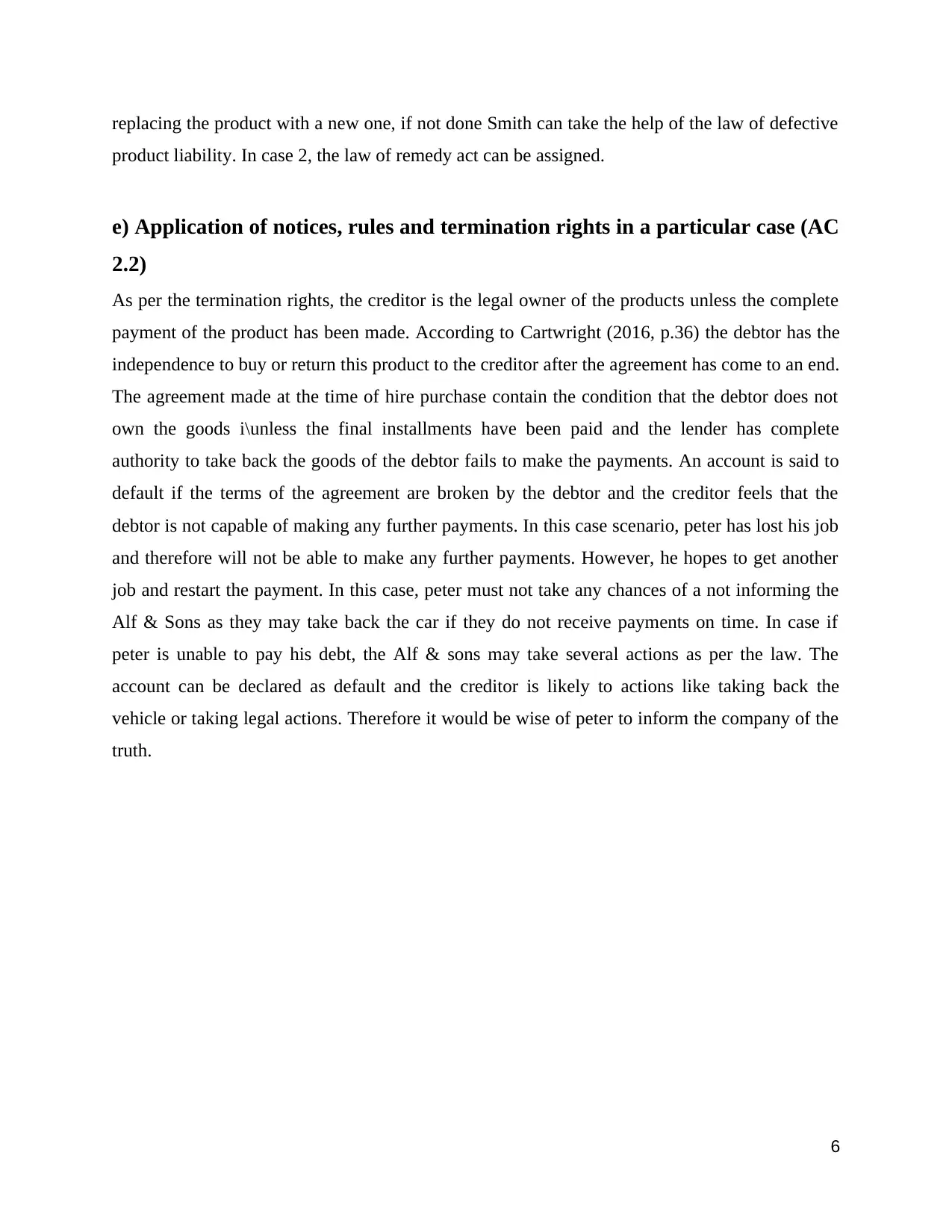
replacing the product with a new one, if not done Smith can take the help of the law of defective
product liability. In case 2, the law of remedy act can be assigned.
e) Application of notices, rules and termination rights in a particular case (AC
2.2)
As per the termination rights, the creditor is the legal owner of the products unless the complete
payment of the product has been made. According to Cartwright (2016, p.36) the debtor has the
independence to buy or return this product to the creditor after the agreement has come to an end.
The agreement made at the time of hire purchase contain the condition that the debtor does not
own the goods i\unless the final installments have been paid and the lender has complete
authority to take back the goods of the debtor fails to make the payments. An account is said to
default if the terms of the agreement are broken by the debtor and the creditor feels that the
debtor is not capable of making any further payments. In this case scenario, peter has lost his job
and therefore will not be able to make any further payments. However, he hopes to get another
job and restart the payment. In this case, peter must not take any chances of a not informing the
Alf & Sons as they may take back the car if they do not receive payments on time. In case if
peter is unable to pay his debt, the Alf & sons may take several actions as per the law. The
account can be declared as default and the creditor is likely to actions like taking back the
vehicle or taking legal actions. Therefore it would be wise of peter to inform the company of the
truth.
6
product liability. In case 2, the law of remedy act can be assigned.
e) Application of notices, rules and termination rights in a particular case (AC
2.2)
As per the termination rights, the creditor is the legal owner of the products unless the complete
payment of the product has been made. According to Cartwright (2016, p.36) the debtor has the
independence to buy or return this product to the creditor after the agreement has come to an end.
The agreement made at the time of hire purchase contain the condition that the debtor does not
own the goods i\unless the final installments have been paid and the lender has complete
authority to take back the goods of the debtor fails to make the payments. An account is said to
default if the terms of the agreement are broken by the debtor and the creditor feels that the
debtor is not capable of making any further payments. In this case scenario, peter has lost his job
and therefore will not be able to make any further payments. However, he hopes to get another
job and restart the payment. In this case, peter must not take any chances of a not informing the
Alf & Sons as they may take back the car if they do not receive payments on time. In case if
peter is unable to pay his debt, the Alf & sons may take several actions as per the law. The
account can be declared as default and the creditor is likely to actions like taking back the
vehicle or taking legal actions. Therefore it would be wise of peter to inform the company of the
truth.
6
⊘ This is a preview!⊘
Do you want full access?
Subscribe today to unlock all pages.

Trusted by 1+ million students worldwide
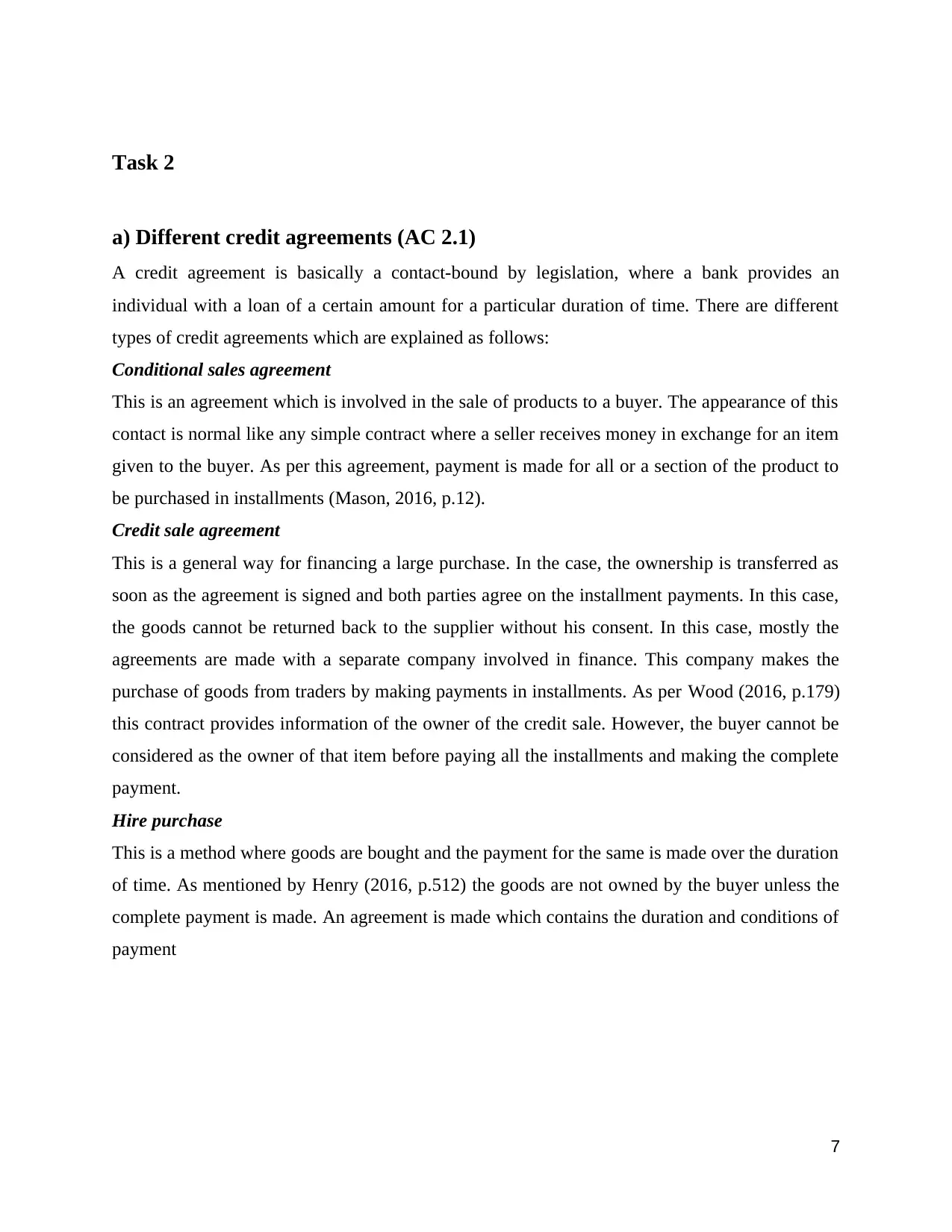
Task 2
a) Different credit agreements (AC 2.1)
A credit agreement is basically a contact-bound by legislation, where a bank provides an
individual with a loan of a certain amount for a particular duration of time. There are different
types of credit agreements which are explained as follows:
Conditional sales agreement
This is an agreement which is involved in the sale of products to a buyer. The appearance of this
contact is normal like any simple contract where a seller receives money in exchange for an item
given to the buyer. As per this agreement, payment is made for all or a section of the product to
be purchased in installments (Mason, 2016, p.12).
Credit sale agreement
This is a general way for financing a large purchase. In the case, the ownership is transferred as
soon as the agreement is signed and both parties agree on the installment payments. In this case,
the goods cannot be returned back to the supplier without his consent. In this case, mostly the
agreements are made with a separate company involved in finance. This company makes the
purchase of goods from traders by making payments in installments. As per Wood (2016, p.179)
this contract provides information of the owner of the credit sale. However, the buyer cannot be
considered as the owner of that item before paying all the installments and making the complete
payment.
Hire purchase
This is a method where goods are bought and the payment for the same is made over the duration
of time. As mentioned by Henry (2016, p.512) the goods are not owned by the buyer unless the
complete payment is made. An agreement is made which contains the duration and conditions of
payment
7
a) Different credit agreements (AC 2.1)
A credit agreement is basically a contact-bound by legislation, where a bank provides an
individual with a loan of a certain amount for a particular duration of time. There are different
types of credit agreements which are explained as follows:
Conditional sales agreement
This is an agreement which is involved in the sale of products to a buyer. The appearance of this
contact is normal like any simple contract where a seller receives money in exchange for an item
given to the buyer. As per this agreement, payment is made for all or a section of the product to
be purchased in installments (Mason, 2016, p.12).
Credit sale agreement
This is a general way for financing a large purchase. In the case, the ownership is transferred as
soon as the agreement is signed and both parties agree on the installment payments. In this case,
the goods cannot be returned back to the supplier without his consent. In this case, mostly the
agreements are made with a separate company involved in finance. This company makes the
purchase of goods from traders by making payments in installments. As per Wood (2016, p.179)
this contract provides information of the owner of the credit sale. However, the buyer cannot be
considered as the owner of that item before paying all the installments and making the complete
payment.
Hire purchase
This is a method where goods are bought and the payment for the same is made over the duration
of time. As mentioned by Henry (2016, p.512) the goods are not owned by the buyer unless the
complete payment is made. An agreement is made which contains the duration and conditions of
payment
7
Paraphrase This Document
Need a fresh take? Get an instant paraphrase of this document with our AI Paraphraser
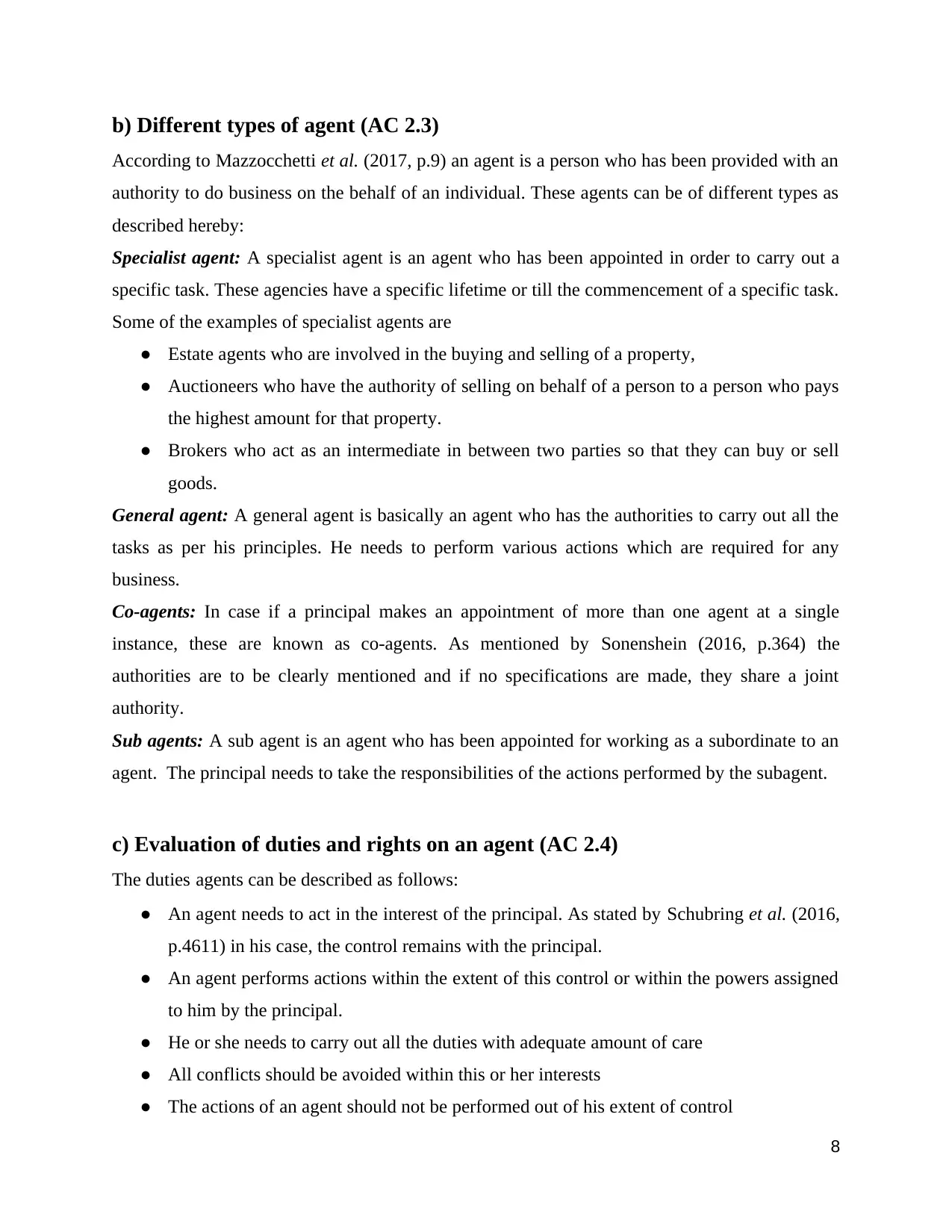
b) Different types of agent (AC 2.3)
According to Mazzocchetti et al. (2017, p.9) an agent is a person who has been provided with an
authority to do business on the behalf of an individual. These agents can be of different types as
described hereby:
Specialist agent: A specialist agent is an agent who has been appointed in order to carry out a
specific task. These agencies have a specific lifetime or till the commencement of a specific task.
Some of the examples of specialist agents are
● Estate agents who are involved in the buying and selling of a property,
● Auctioneers who have the authority of selling on behalf of a person to a person who pays
the highest amount for that property.
● Brokers who act as an intermediate in between two parties so that they can buy or sell
goods.
General agent: A general agent is basically an agent who has the authorities to carry out all the
tasks as per his principles. He needs to perform various actions which are required for any
business.
Co-agents: In case if a principal makes an appointment of more than one agent at a single
instance, these are known as co-agents. As mentioned by Sonenshein (2016, p.364) the
authorities are to be clearly mentioned and if no specifications are made, they share a joint
authority.
Sub agents: A sub agent is an agent who has been appointed for working as a subordinate to an
agent. The principal needs to take the responsibilities of the actions performed by the subagent.
c) Evaluation of duties and rights on an agent (AC 2.4)
The duties agents can be described as follows:
● An agent needs to act in the interest of the principal. As stated by Schubring et al. (2016,
p.4611) in his case, the control remains with the principal.
● An agent performs actions within the extent of this control or within the powers assigned
to him by the principal.
● He or she needs to carry out all the duties with adequate amount of care
● All conflicts should be avoided within this or her interests
● The actions of an agent should not be performed out of his extent of control
8
According to Mazzocchetti et al. (2017, p.9) an agent is a person who has been provided with an
authority to do business on the behalf of an individual. These agents can be of different types as
described hereby:
Specialist agent: A specialist agent is an agent who has been appointed in order to carry out a
specific task. These agencies have a specific lifetime or till the commencement of a specific task.
Some of the examples of specialist agents are
● Estate agents who are involved in the buying and selling of a property,
● Auctioneers who have the authority of selling on behalf of a person to a person who pays
the highest amount for that property.
● Brokers who act as an intermediate in between two parties so that they can buy or sell
goods.
General agent: A general agent is basically an agent who has the authorities to carry out all the
tasks as per his principles. He needs to perform various actions which are required for any
business.
Co-agents: In case if a principal makes an appointment of more than one agent at a single
instance, these are known as co-agents. As mentioned by Sonenshein (2016, p.364) the
authorities are to be clearly mentioned and if no specifications are made, they share a joint
authority.
Sub agents: A sub agent is an agent who has been appointed for working as a subordinate to an
agent. The principal needs to take the responsibilities of the actions performed by the subagent.
c) Evaluation of duties and rights on an agent (AC 2.4)
The duties agents can be described as follows:
● An agent needs to act in the interest of the principal. As stated by Schubring et al. (2016,
p.4611) in his case, the control remains with the principal.
● An agent performs actions within the extent of this control or within the powers assigned
to him by the principal.
● He or she needs to carry out all the duties with adequate amount of care
● All conflicts should be avoided within this or her interests
● The actions of an agent should not be performed out of his extent of control
8
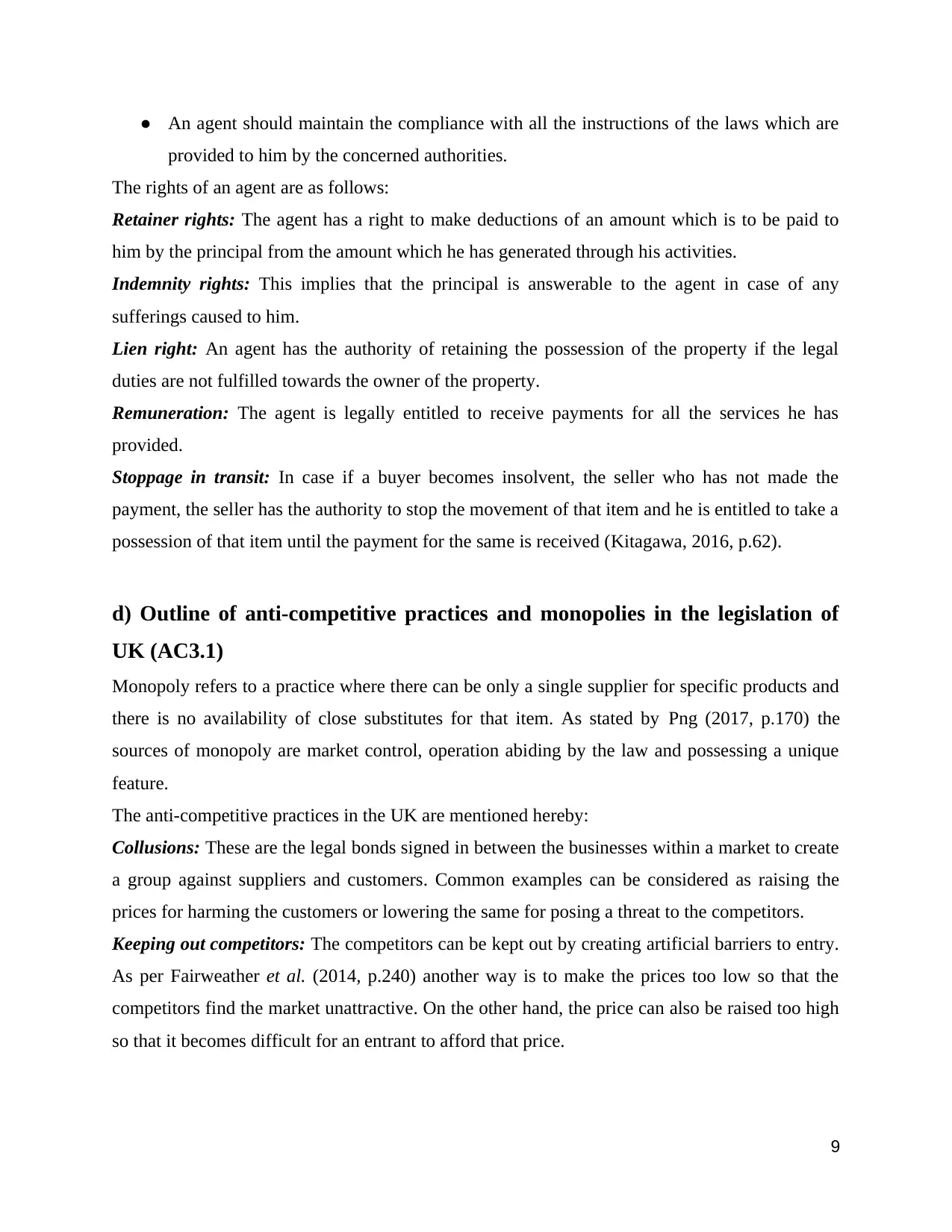
● An agent should maintain the compliance with all the instructions of the laws which are
provided to him by the concerned authorities.
The rights of an agent are as follows:
Retainer rights: The agent has a right to make deductions of an amount which is to be paid to
him by the principal from the amount which he has generated through his activities.
Indemnity rights: This implies that the principal is answerable to the agent in case of any
sufferings caused to him.
Lien right: An agent has the authority of retaining the possession of the property if the legal
duties are not fulfilled towards the owner of the property.
Remuneration: The agent is legally entitled to receive payments for all the services he has
provided.
Stoppage in transit: In case if a buyer becomes insolvent, the seller who has not made the
payment, the seller has the authority to stop the movement of that item and he is entitled to take a
possession of that item until the payment for the same is received (Kitagawa, 2016, p.62).
d) Outline of anti-competitive practices and monopolies in the legislation of
UK (AC3.1)
Monopoly refers to a practice where there can be only a single supplier for specific products and
there is no availability of close substitutes for that item. As stated by Png (2017, p.170) the
sources of monopoly are market control, operation abiding by the law and possessing a unique
feature.
The anti-competitive practices in the UK are mentioned hereby:
Collusions: These are the legal bonds signed in between the businesses within a market to create
a group against suppliers and customers. Common examples can be considered as raising the
prices for harming the customers or lowering the same for posing a threat to the competitors.
Keeping out competitors: The competitors can be kept out by creating artificial barriers to entry.
As per Fairweather et al. (2014, p.240) another way is to make the prices too low so that the
competitors find the market unattractive. On the other hand, the price can also be raised too high
so that it becomes difficult for an entrant to afford that price.
9
provided to him by the concerned authorities.
The rights of an agent are as follows:
Retainer rights: The agent has a right to make deductions of an amount which is to be paid to
him by the principal from the amount which he has generated through his activities.
Indemnity rights: This implies that the principal is answerable to the agent in case of any
sufferings caused to him.
Lien right: An agent has the authority of retaining the possession of the property if the legal
duties are not fulfilled towards the owner of the property.
Remuneration: The agent is legally entitled to receive payments for all the services he has
provided.
Stoppage in transit: In case if a buyer becomes insolvent, the seller who has not made the
payment, the seller has the authority to stop the movement of that item and he is entitled to take a
possession of that item until the payment for the same is received (Kitagawa, 2016, p.62).
d) Outline of anti-competitive practices and monopolies in the legislation of
UK (AC3.1)
Monopoly refers to a practice where there can be only a single supplier for specific products and
there is no availability of close substitutes for that item. As stated by Png (2017, p.170) the
sources of monopoly are market control, operation abiding by the law and possessing a unique
feature.
The anti-competitive practices in the UK are mentioned hereby:
Collusions: These are the legal bonds signed in between the businesses within a market to create
a group against suppliers and customers. Common examples can be considered as raising the
prices for harming the customers or lowering the same for posing a threat to the competitors.
Keeping out competitors: The competitors can be kept out by creating artificial barriers to entry.
As per Fairweather et al. (2014, p.240) another way is to make the prices too low so that the
competitors find the market unattractive. On the other hand, the price can also be raised too high
so that it becomes difficult for an entrant to afford that price.
9
⊘ This is a preview!⊘
Do you want full access?
Subscribe today to unlock all pages.

Trusted by 1+ million students worldwide
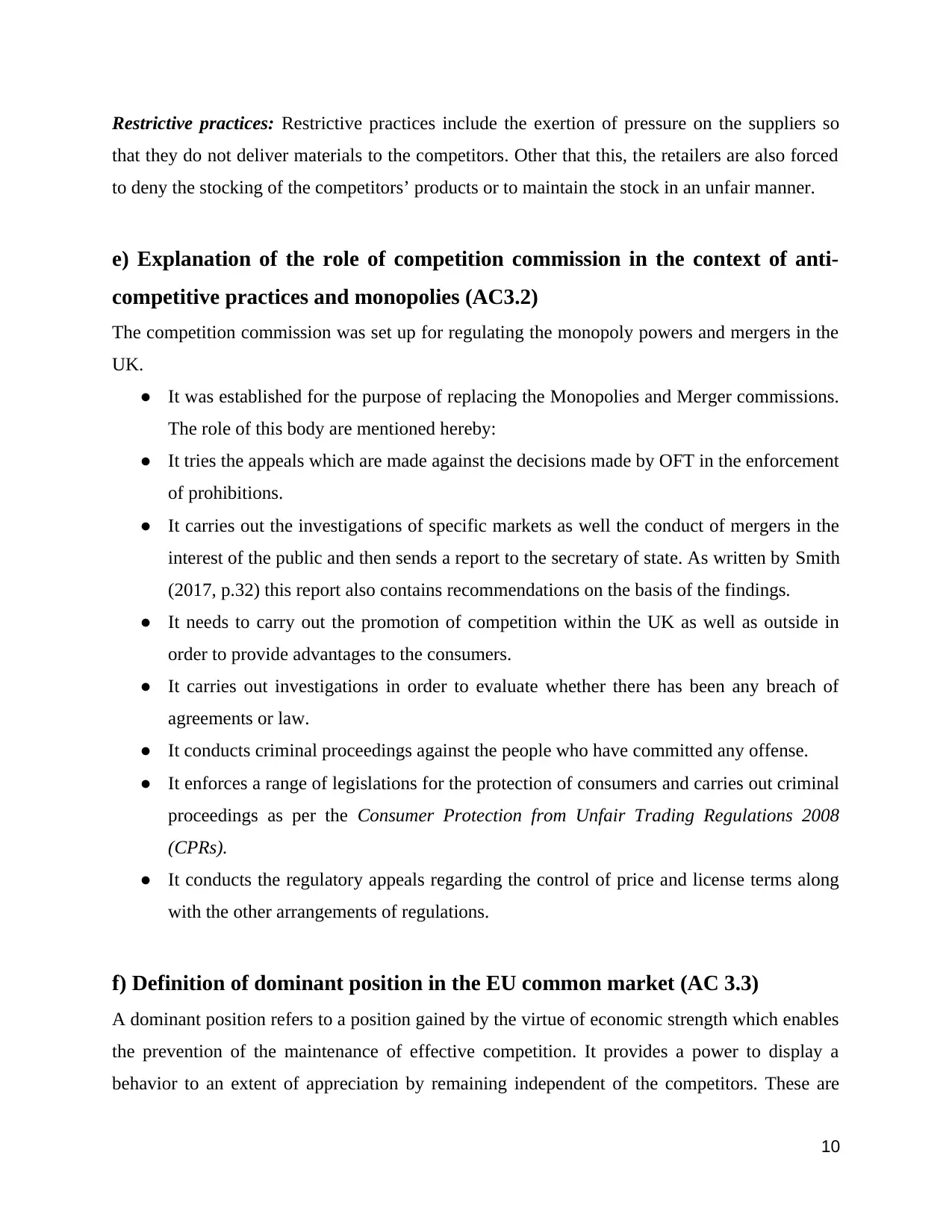
Restrictive practices: Restrictive practices include the exertion of pressure on the suppliers so
that they do not deliver materials to the competitors. Other that this, the retailers are also forced
to deny the stocking of the competitors’ products or to maintain the stock in an unfair manner.
e) Explanation of the role of competition commission in the context of anti-
competitive practices and monopolies (AC3.2)
The competition commission was set up for regulating the monopoly powers and mergers in the
UK.
● It was established for the purpose of replacing the Monopolies and Merger commissions.
The role of this body are mentioned hereby:
● It tries the appeals which are made against the decisions made by OFT in the enforcement
of prohibitions.
● It carries out the investigations of specific markets as well the conduct of mergers in the
interest of the public and then sends a report to the secretary of state. As written by Smith
(2017, p.32) this report also contains recommendations on the basis of the findings.
● It needs to carry out the promotion of competition within the UK as well as outside in
order to provide advantages to the consumers.
● It carries out investigations in order to evaluate whether there has been any breach of
agreements or law.
● It conducts criminal proceedings against the people who have committed any offense.
● It enforces a range of legislations for the protection of consumers and carries out criminal
proceedings as per the Consumer Protection from Unfair Trading Regulations 2008
(CPRs).
● It conducts the regulatory appeals regarding the control of price and license terms along
with the other arrangements of regulations.
f) Definition of dominant position in the EU common market (AC 3.3)
A dominant position refers to a position gained by the virtue of economic strength which enables
the prevention of the maintenance of effective competition. It provides a power to display a
behavior to an extent of appreciation by remaining independent of the competitors. These are
10
that they do not deliver materials to the competitors. Other that this, the retailers are also forced
to deny the stocking of the competitors’ products or to maintain the stock in an unfair manner.
e) Explanation of the role of competition commission in the context of anti-
competitive practices and monopolies (AC3.2)
The competition commission was set up for regulating the monopoly powers and mergers in the
UK.
● It was established for the purpose of replacing the Monopolies and Merger commissions.
The role of this body are mentioned hereby:
● It tries the appeals which are made against the decisions made by OFT in the enforcement
of prohibitions.
● It carries out the investigations of specific markets as well the conduct of mergers in the
interest of the public and then sends a report to the secretary of state. As written by Smith
(2017, p.32) this report also contains recommendations on the basis of the findings.
● It needs to carry out the promotion of competition within the UK as well as outside in
order to provide advantages to the consumers.
● It carries out investigations in order to evaluate whether there has been any breach of
agreements or law.
● It conducts criminal proceedings against the people who have committed any offense.
● It enforces a range of legislations for the protection of consumers and carries out criminal
proceedings as per the Consumer Protection from Unfair Trading Regulations 2008
(CPRs).
● It conducts the regulatory appeals regarding the control of price and license terms along
with the other arrangements of regulations.
f) Definition of dominant position in the EU common market (AC 3.3)
A dominant position refers to a position gained by the virtue of economic strength which enables
the prevention of the maintenance of effective competition. It provides a power to display a
behavior to an extent of appreciation by remaining independent of the competitors. These are
10
Paraphrase This Document
Need a fresh take? Get an instant paraphrase of this document with our AI Paraphraser
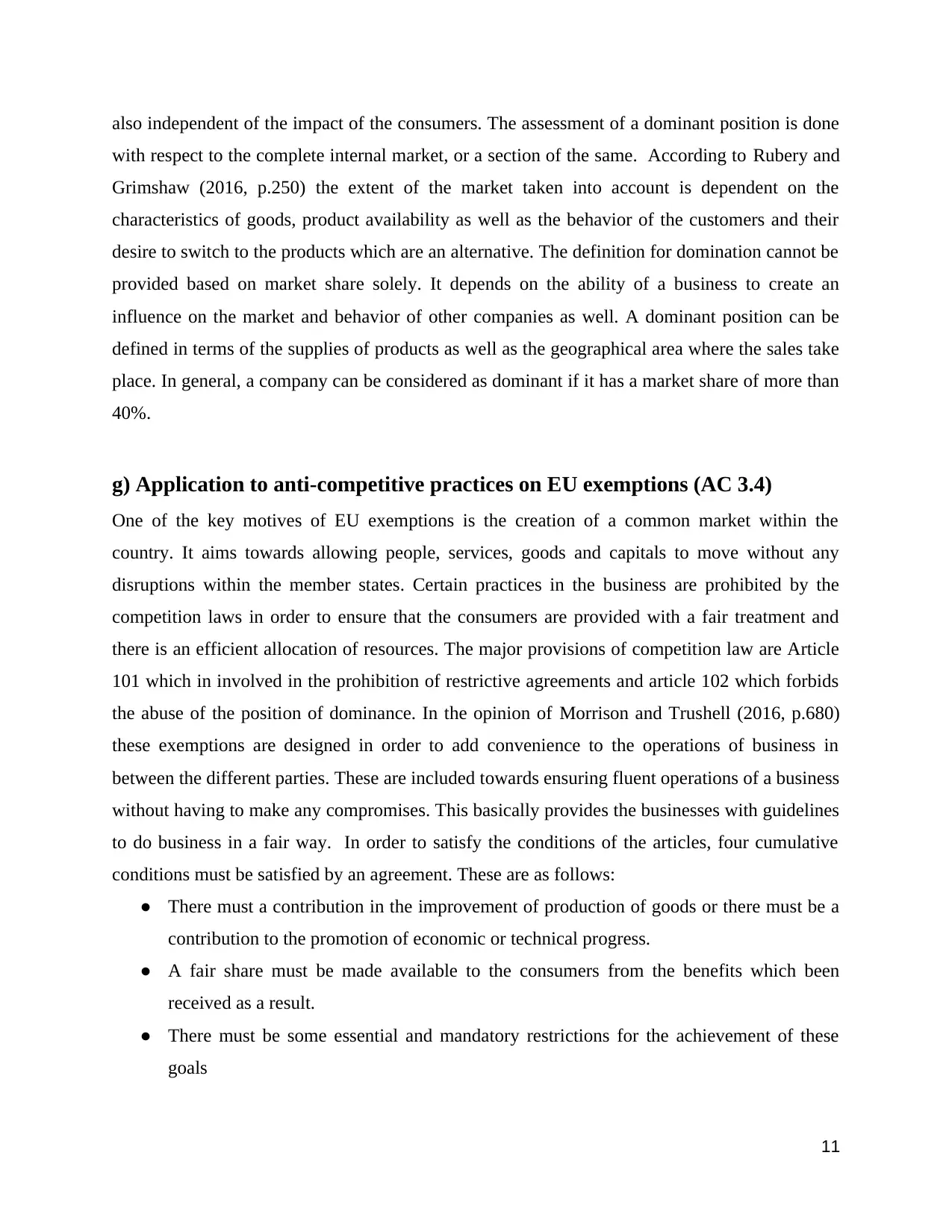
also independent of the impact of the consumers. The assessment of a dominant position is done
with respect to the complete internal market, or a section of the same. According to Rubery and
Grimshaw (2016, p.250) the extent of the market taken into account is dependent on the
characteristics of goods, product availability as well as the behavior of the customers and their
desire to switch to the products which are an alternative. The definition for domination cannot be
provided based on market share solely. It depends on the ability of a business to create an
influence on the market and behavior of other companies as well. A dominant position can be
defined in terms of the supplies of products as well as the geographical area where the sales take
place. In general, a company can be considered as dominant if it has a market share of more than
40%.
g) Application to anti-competitive practices on EU exemptions (AC 3.4)
One of the key motives of EU exemptions is the creation of a common market within the
country. It aims towards allowing people, services, goods and capitals to move without any
disruptions within the member states. Certain practices in the business are prohibited by the
competition laws in order to ensure that the consumers are provided with a fair treatment and
there is an efficient allocation of resources. The major provisions of competition law are Article
101 which in involved in the prohibition of restrictive agreements and article 102 which forbids
the abuse of the position of dominance. In the opinion of Morrison and Trushell (2016, p.680)
these exemptions are designed in order to add convenience to the operations of business in
between the different parties. These are included towards ensuring fluent operations of a business
without having to make any compromises. This basically provides the businesses with guidelines
to do business in a fair way. In order to satisfy the conditions of the articles, four cumulative
conditions must be satisfied by an agreement. These are as follows:
● There must a contribution in the improvement of production of goods or there must be a
contribution to the promotion of economic or technical progress.
● A fair share must be made available to the consumers from the benefits which been
received as a result.
● There must be some essential and mandatory restrictions for the achievement of these
goals
11
with respect to the complete internal market, or a section of the same. According to Rubery and
Grimshaw (2016, p.250) the extent of the market taken into account is dependent on the
characteristics of goods, product availability as well as the behavior of the customers and their
desire to switch to the products which are an alternative. The definition for domination cannot be
provided based on market share solely. It depends on the ability of a business to create an
influence on the market and behavior of other companies as well. A dominant position can be
defined in terms of the supplies of products as well as the geographical area where the sales take
place. In general, a company can be considered as dominant if it has a market share of more than
40%.
g) Application to anti-competitive practices on EU exemptions (AC 3.4)
One of the key motives of EU exemptions is the creation of a common market within the
country. It aims towards allowing people, services, goods and capitals to move without any
disruptions within the member states. Certain practices in the business are prohibited by the
competition laws in order to ensure that the consumers are provided with a fair treatment and
there is an efficient allocation of resources. The major provisions of competition law are Article
101 which in involved in the prohibition of restrictive agreements and article 102 which forbids
the abuse of the position of dominance. In the opinion of Morrison and Trushell (2016, p.680)
these exemptions are designed in order to add convenience to the operations of business in
between the different parties. These are included towards ensuring fluent operations of a business
without having to make any compromises. This basically provides the businesses with guidelines
to do business in a fair way. In order to satisfy the conditions of the articles, four cumulative
conditions must be satisfied by an agreement. These are as follows:
● There must a contribution in the improvement of production of goods or there must be a
contribution to the promotion of economic or technical progress.
● A fair share must be made available to the consumers from the benefits which been
received as a result.
● There must be some essential and mandatory restrictions for the achievement of these
goals
11
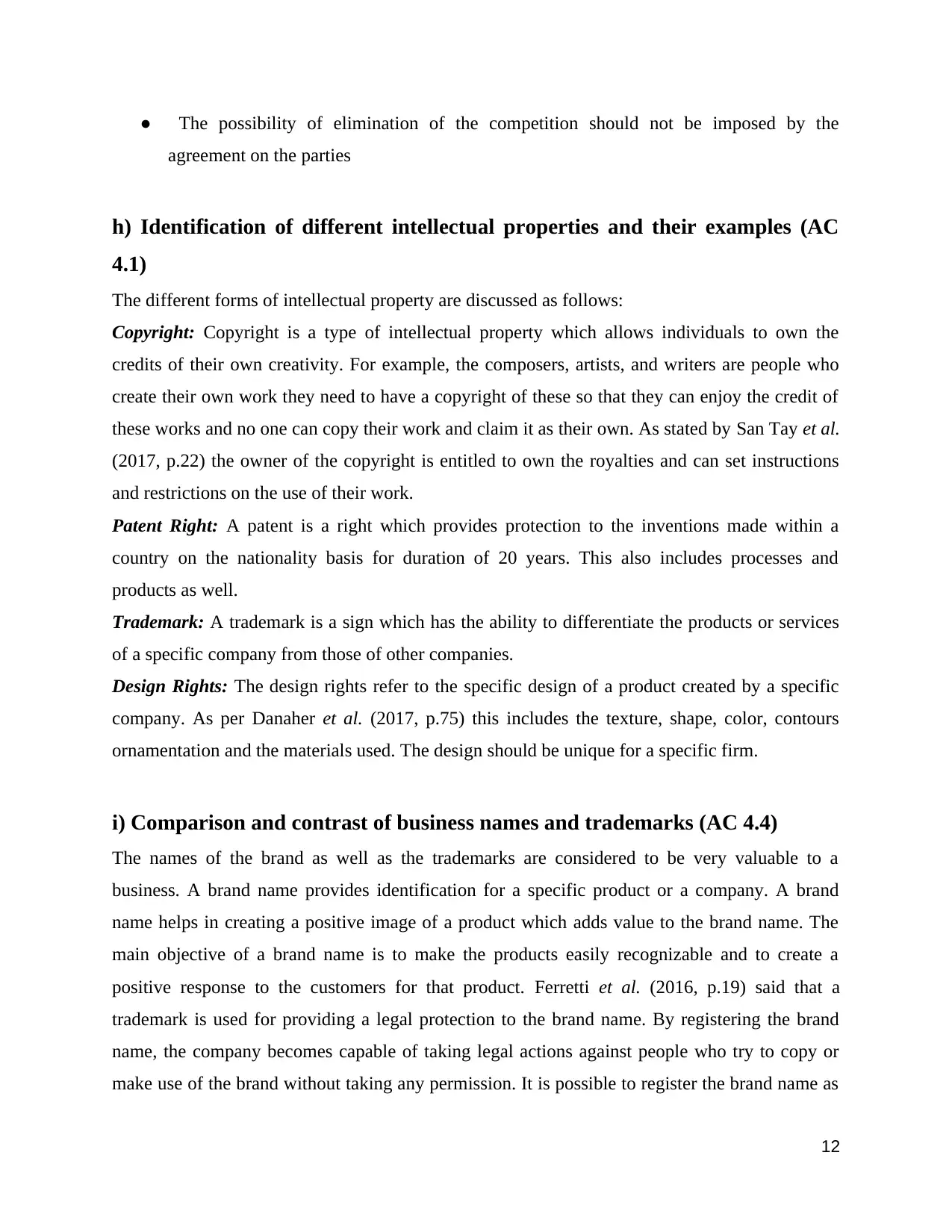
● The possibility of elimination of the competition should not be imposed by the
agreement on the parties
h) Identification of different intellectual properties and their examples (AC
4.1)
The different forms of intellectual property are discussed as follows:
Copyright: Copyright is a type of intellectual property which allows individuals to own the
credits of their own creativity. For example, the composers, artists, and writers are people who
create their own work they need to have a copyright of these so that they can enjoy the credit of
these works and no one can copy their work and claim it as their own. As stated by San Tay et al.
(2017, p.22) the owner of the copyright is entitled to own the royalties and can set instructions
and restrictions on the use of their work.
Patent Right: A patent is a right which provides protection to the inventions made within a
country on the nationality basis for duration of 20 years. This also includes processes and
products as well.
Trademark: A trademark is a sign which has the ability to differentiate the products or services
of a specific company from those of other companies.
Design Rights: The design rights refer to the specific design of a product created by a specific
company. As per Danaher et al. (2017, p.75) this includes the texture, shape, color, contours
ornamentation and the materials used. The design should be unique for a specific firm.
i) Comparison and contrast of business names and trademarks (AC 4.4)
The names of the brand as well as the trademarks are considered to be very valuable to a
business. A brand name provides identification for a specific product or a company. A brand
name helps in creating a positive image of a product which adds value to the brand name. The
main objective of a brand name is to make the products easily recognizable and to create a
positive response to the customers for that product. Ferretti et al. (2016, p.19) said that a
trademark is used for providing a legal protection to the brand name. By registering the brand
name, the company becomes capable of taking legal actions against people who try to copy or
make use of the brand without taking any permission. It is possible to register the brand name as
12
agreement on the parties
h) Identification of different intellectual properties and their examples (AC
4.1)
The different forms of intellectual property are discussed as follows:
Copyright: Copyright is a type of intellectual property which allows individuals to own the
credits of their own creativity. For example, the composers, artists, and writers are people who
create their own work they need to have a copyright of these so that they can enjoy the credit of
these works and no one can copy their work and claim it as their own. As stated by San Tay et al.
(2017, p.22) the owner of the copyright is entitled to own the royalties and can set instructions
and restrictions on the use of their work.
Patent Right: A patent is a right which provides protection to the inventions made within a
country on the nationality basis for duration of 20 years. This also includes processes and
products as well.
Trademark: A trademark is a sign which has the ability to differentiate the products or services
of a specific company from those of other companies.
Design Rights: The design rights refer to the specific design of a product created by a specific
company. As per Danaher et al. (2017, p.75) this includes the texture, shape, color, contours
ornamentation and the materials used. The design should be unique for a specific firm.
i) Comparison and contrast of business names and trademarks (AC 4.4)
The names of the brand as well as the trademarks are considered to be very valuable to a
business. A brand name provides identification for a specific product or a company. A brand
name helps in creating a positive image of a product which adds value to the brand name. The
main objective of a brand name is to make the products easily recognizable and to create a
positive response to the customers for that product. Ferretti et al. (2016, p.19) said that a
trademark is used for providing a legal protection to the brand name. By registering the brand
name, the company becomes capable of taking legal actions against people who try to copy or
make use of the brand without taking any permission. It is possible to register the brand name as
12
⊘ This is a preview!⊘
Do you want full access?
Subscribe today to unlock all pages.

Trusted by 1+ million students worldwide
1 out of 17
Related Documents
Your All-in-One AI-Powered Toolkit for Academic Success.
+13062052269
info@desklib.com
Available 24*7 on WhatsApp / Email
![[object Object]](/_next/static/media/star-bottom.7253800d.svg)
Unlock your academic potential
Copyright © 2020–2025 A2Z Services. All Rights Reserved. Developed and managed by ZUCOL.





